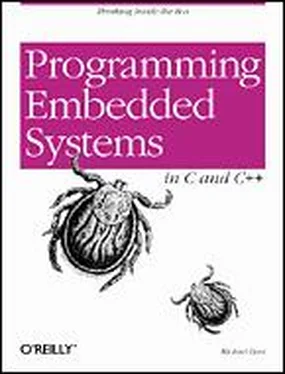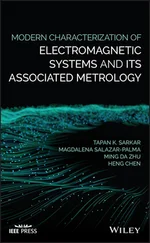The third member of the hybrid memory class is NVRAM (nonvolatile RAM). Nonvolatility is also a characteristic of the ROM and hybrid memories discussed earlier. However, an NVRAM is physically very different from those devices. An NVRAM is usually just an SRAM with a battery backup. When the power is turned on, the NVRAM operates just like any other SRAM. But when the power is turned off, the NVRAM draws just enough electrical power from the battery to retain its current contents. NVRAM is fairly common in embedded systems. However, it is very expensive — even more expensive than SRAM — so its applications are typically limited to the storage of only a few hundred bytes of system-critical information that cannot be stored in any better way.
Table 6-1 summarizes the characteristics of different memory types.
Table 6-1. Memory Device Characteristics
| Memory Type |
Volatile? |
Writeable? |
Erase Size |
Erase Cycles |
Relative Cost |
Relative Speed |
| SRAM |
yes |
yes |
byte |
unlimited |
expensive |
fast |
| DRAM |
yes |
yes |
byte |
unlimited |
moderate |
moderate |
| Masked ROM |
no |
no |
n/a |
n/a |
inexpensive |
fast |
| PROM |
no |
once, with programmer |
n/a |
n/a |
moderate |
fast |
| EPROM |
no |
yes, with programmer |
entire chip |
limited (see specs) |
moderate |
fast |
| EEPROM |
no |
yes |
byte |
limited (see specs) |
expensive |
fast to read, slow to write |
| Flash |
no |
yes |
sector |
limited (see specs) |
moderate |
fast to read, slow to write |
| NVRAM |
no |
yes |
byte |
none |
expensive |
fast |
One of the first pieces of serious embedded software you are likely to write is a memory test. Once the prototype hardware is ready, the designer would like some reassurance that she has wired the address and data lines correctly and that the memory chips are working properly. At first this might seem like a fairly simple assignment, but as you look at the problem more closely you will realize that it can be difficult to detect subtle memory problems with a simple test. In fact, as a result of programmer naivetй, many embedded systems include memory tests that would detect only the most catastrophic memory failures. Some of these might not even notice that the memory chips have been removed from the board!
Direct Memory Access
Direct memory access (DMA) is a technique for transferring blocks of data directly between two hardware devices. In the absence of DMA, the processor must read the data from one device and write it to the other, one byte or word at a time. If the amount of data to be transferred is large, or the frequency of transfers is high, the rest of the software might never get a chance to run. However, if a DMA controller is present it is possible to have it perform the entire transfer, with little assistance from the processor.
Here's how DMA works. When a block of data needs to be transferred, the processor provides the DMA controller with the source and destination addresses and the total number of bytes. The DMA controller then transfers the data from the source to the destination automatically. After each byte is copied, each address is incremented and the number of bytes remaining is reduced by one. When the number of bytes remaining reaches zero, the block transfer ends and the DMA controller sends an interrupt to the processor.
In a typical DMA scenario, the block of data is transferred directly to or from memory. For example, a network controller might want to place an incoming network packet into memory as it arrives, but only notify the processor once the entire packet has been received. By using DMA, the processor can spend more time processing the data once it arrives and less time transferring it between devices. The processor and DMA controller must share the address and data buses during this time, but this is handled automatically by the hardware and the processor is otherwise uninvolved with the actual transfer.
The purpose of a memory test is to confirm that each storage location in a memory device is working. In other words, if you store the number 50 at a particular address, you expect to find that number stored there until another number is written. The basic idea behind any memory test, then, is to write some set of data values to each address in the memory device and verify the data by reading it back. If all the values read back are the same as those that were written, then the memory device is said to pass the test. As you will see, it is only through careful selection of the set of data values that you can be sure that a passing result is meaningful.
Of course, a memory test like the one just described is unavoidably destructive. In the process of testing the memory, you must overwrite its prior contents. Because it is generally impractical to overwrite the contents of nonvolatile memories, the tests described in this section are generally used only for RAM testing. However, if the contents of a hybrid memory are unimportant — as they are during the product development stage — these same algorithms can be used to test those devices as well. The problem of validating the contents of a nonvolatile memory is addressed in a later section of this chapter.
6.2.1 Common Memory Problems
Before learning about specific test algorithms, you should be familiar with the types of memory problems that are likely to occur. One common misconception among software engineers is that most memory problems occur within the chips themselves. Though a major issue at one time (a few decades ago), problems of this type are increasingly rare. The manufacturers of memory devices perform a variety of post-production tests on each batch of chips. If there is a problem with a particular batch, it is extremely unlikely that one of the bad chips will make its way into your system.
The one type of memory chip problem you could encounter is a catastrophic failure. This is usually caused by some sort of physical or electrical damage received by the chip after manufacture. Catastrophic failures are uncommon and usually affect large portions of the chip. Because a large area is affected, it is reasonable to assume that catastrophic failure will be detected by any decent test algorithm.
In my experience, a more common source of memory problems is the circuit board. Typical circuit board problems are:
• Problems with the wiring between the processor and memory device
• Missing memory chips
• Improperly inserted memory chips
These are the problems that a good memory test algorithm should be able to detect. Such a test should also be able to detect catastrophic memory failures without specifically looking for them. So let's discuss circuit board problems in more detail.
6.2.1.1 Electrical wiring problems
An electrical wiring problem could be caused by an error in design or production of the board or as the result of damage received after manufacture. Each of the wires that connect the memory device to the processor is one of three types: an address line, a data line, or a control line. The address and data lines are used to select the memory location and to transfer the data, respectively. The control lines tell the memory device whether the processor wants to read or write the location and precisely when the data will be transferred. Unfortunately, one or more of these wires could be improperly routed or damaged in such a way that it is either shorted (i.e., connected to another wire on the board) or open (not connected to anything). These problems are often caused by a bit of solder splash or a broken trace, respectively. Both cases are illustrated in Figure 6-2.
Читать дальше












